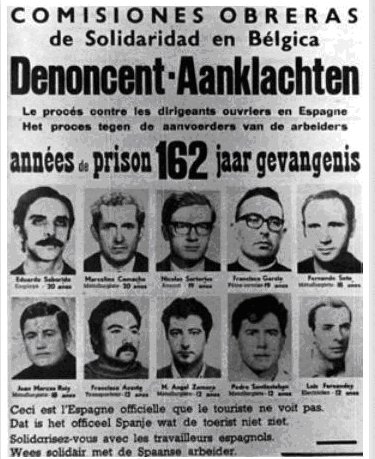Criteris correcció_CC.OO
TRADE UNIONISTS FROM CCOO ARRESTED
 |
- What kind of source is it? What is about? Is it a primary or a secondary source. Justify your opinion.
It is a primary source, contemporary of the facts. It is a poster, iconographical and a public source with political content or with a political message.
2.- When was it created? What was happening during this period? (2 points)
( explain the national context)
It is about a trial in 1972 against 10 trade unionists (called the 10 from Carabanchel), members of the union CCOO, who were condemned to a total of 162 years in jail because of their activism.
3.- Explain how trade unions developed during Francoism from 1960 to 1975.
Students can contextualized with the situation before 1960. The anarchist union, CNT, had almost disintegrated. The first strikes were in the textile sector in 1946 to 1948. During the 1950s workers linked to left-wing organizations started the strategy of occupying positions as union representatives within the only legal union (CNS). In 1957 there was a miners’ strike in Asturias and the first workers’ commission (comissió obrera) was created. In 1964 several recently created unions joined CCOO. From 1967 CCOO was systematically persecuted. It was linked to the communist party at that time and it would become the most important union in Spain during this period. The workers made a number of strikes, led by CCOO from 1960 forced the government to dictate the first Law of Collective Bargaining in 1958, and the second one in 1973. In 1974 and 1975, there were general strikes around. Among other things, they wanted union freedom.
4.- What do you know about CC. OO? When, why and how it was created? (6-7 lines) (1 point).
5.- During this period, which parties, unions and associations opposed Francoism?
Students should point out that the opposition was led by the communist party and that still the socialist party existed as well, although was not so active and had their leaders in exile. In the 60s, students’ movement was important in within universities new parties in the left were created, independent from the communist or other parties, in the so called “New Left”. Students should write about conflict in universities with the student’s movement and also about neighbours’ associations and the democratic platforms at the end of the period such as the Assembly of Catalonia, the “Junta Democrática” or the “Platajunta”.